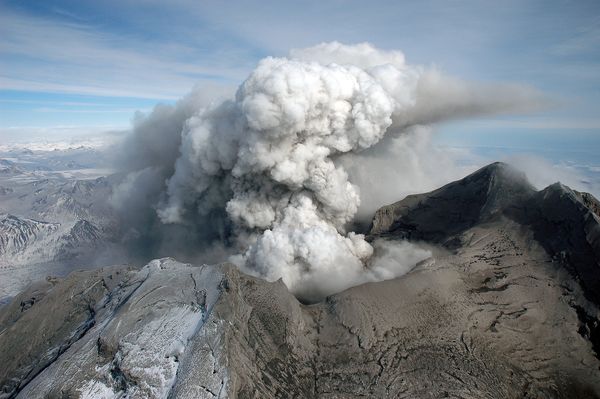Volcano's "Scream" Before Eruption Explained
Redoubt volcano is shown heavily covered with deposits from recent eruptions.
The small earthquakes that foreshadow some volcanic explosions produce a hum that rises in frequency but then abruptly stops just before an eruption.
Known as a harmonic tremor, this noise has been recorded at various volcanoes around the world, including Alaska's Redoubt Volcano.
Redoubt is a special case, however, because its volcanic "scream" reaches such a crescendo that it can actually be audible to human ears.
"At the very highest frequency, it would just be barely perceptible as a low-bass hum," explained Alicia Hotovec-Ellis, a geophysicist at the University of Washington.
The frequency of Redoubt's harmonic tremor is so high, in fact, that it can't easily be explained by many of the accepted theories.
"The pitch that Redoubt got up to was so much higher than any other volcano that we've recorded, and that's kind of pushed the limits of all the models that were out there," Hotovec-Ellis said in an interview Monday.
But in two new studies, published in the Journal of Volcanology and Geothermal Research and Nature Geoscience, Hotovec-Ellis and her colleagues propose a new model to explain Redoubt's unusually high-pitched scream.
So what's new?
Some volcanoes emit sound as a result of magma bubbles vibrating as they're pushed up through cracks in the Earth's crust.
But in Redoubt's case, scientists think the earthquake and harmonic tremor happen as magma is forced through a narrow opening under great pressure into the heart of the mountain.
The thick magma sticks to the rock surface inside the conduit until the building pressure causes it to move higher, where it sticks until the pressure moves it again.
Each of these sudden movements results in a small earthquake. As the pressure builds, the quakes get smaller and happen so quickly one after another that the sounds they generate blend into a continuous and ever increasing noise.
"So it's actually the rocks making the sounds," Hotovec-Ellis said.
Why is it important?
The team's new model could allow scientists to better understand what happens during eruptive cycles in volcanoes like Redoubt.
It could also serve as a limited early warning system, Hotovec-Ellis said.
"For Redoubt, by the time it started to scream like this it had already been erupting for a few days," she explained. "So at most it could give a few minutes or a few hours of warning before the next explosion."
What does this mean?
At Redoubt, the harmonic tremor reaches an extremely high frequency but then goes eerily quiet. Shortly after, the volcano erupts again.
"We think the pause is when even the earthquakes can't keep up anymore and the two sides of the fault slide smoothly against each other," Hotovec-Ellis said in a statement.
The new model could also be applicable to other volcanoes, Hotovec-Ellis said, such as the Soufrière Hills volcano on the Caribbean island of Montserrat.
What's next?
Eric Dunham, a geophysicist at Stanford University and a co-author of the Nature Geosciences study, plans to investigate why the stresses are so high at Redoubt.
"His idea is trying to figure out why the pressure is concentrated in one spot," Hotovec-Ellis said. "We haven't quite figured out why it's just one spot in the volcano that keeps popping off."
The team has created two recordings of Redoubt's seismic activity. A 10-second recording covers about 10 minutes of seismic sound and harmonic tremor, sped up 60 times. A one-minute recording condenses about an hour of activity that includes more than 1,600 small earthquakes that preceded the first explosion with harmonic tremor.
Ker Than
for National Geographic
Published July 15, 2013












